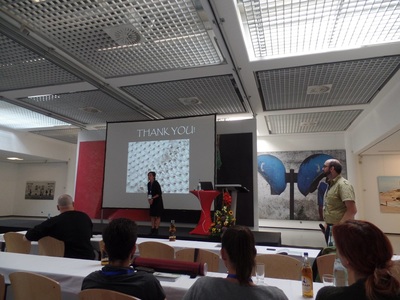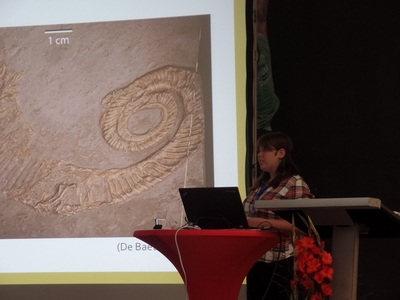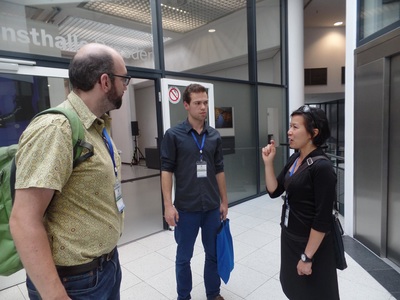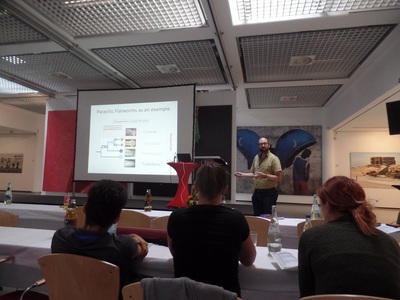|
John Warren Huntley and myself have been working on two volumes on the Evolution and Fossil Record of Parasitism for Topics in Geobiology. We could not have done it without our lovely and patient contributors. The first Volume focusing on "The Identification and Macroevolution of Parasites" was just published. The second Volume entitled "Coevolution and Paleoparasitological Techniques" should follow later this year.
0 Comments
2017 is nearing its end and its time to release our favorite articles of the year. Clearly my list is a personal one which is mostly focused on invertebrates (with some exceptions) as this is where my heart lies. It also is not necessarily exhaustive as I was quite busy this year with teaching and supervising leaving less time to be up-to-date with the literature.This being said these are the articles I enjoyed reading most this year:
Favorite Articles of the year 1) Dunn, F. S., Liu, A. G., & Donoghue, P. C. J. (2017). Ediacaran developmental biology. Biological Reviews; doi: 10.1111/brv.12379 2) Hautmann, M., Ware, D., & Bucher, H. (2017). Geologically oldest oysters were epizoans on Early Triassic ammonoids. Journal of Molluscan Studies, 83(3), 253-260; doi: 10.1093/mollus/eyx018 3) Puttick, M. N., Kriwet, J., Wen, W., Hu, S., Thomas, G. H., & Benton, M. J. (2017). Body length of bony fishes was not a selective factor during the biggest mass extinction of all time. Palaeontology, 60(5), 727-741; doi: 10.1111/pala.12309 4) Eriksson, M. E., Parry, L. A. & Rudkin, D. M. (2017). Earth’s oldest ‘Bobbit worm’ – gigantism in a Devonian eunicidan polychaete. Scientific Reports 7, 43061; doi: 10.1038/srep43061 5) Ferrón, H. G., Martínez-Pérez, C. & Botella, H. (2017). Ecomorphological inferences in early vertebrates: reconstructing Dunkleosteus terrelli (Arthrodira, Placodermi) caudal fin from palaeoecological data. PeerJ, 5:e4081; doi: 10.7717/peerj.4081 6) Trenchard, H., Brett, C. E. & Perc, M. (2017). Trilobite ‘pelotons’: possible hydrodynamic drag effects between leading and following trilobites in trilobite queues. Palaeontology, 60, 557–569; doi: 10.1111/pala.12301 7) Tanner, A. R., Fuchs, D., Winkelmann, I. E., Gilbert, M. T. P., Pankey, M. S., Ribeiro, Â. M., Kocot, K. M., Halanych, K. M., Oakley, T. H. & Pisani, D. (2017). Molecular clocks indicate turnover and diversification of modern coleoid cephalopods during the Mesozoic Marine Revolution. Proceedings of the Royal Society B, 284 (1850), 20162818; doi: 10.1098/rspb.2016.2818 8) Bomfleur B, Grimm GW, McLoughlin S. (2017) The fossil Osmundales (Royal Ferns)—a phylogenetic network analysis, revised taxonomy, and evolutionary classification of anatomically preserved trunks and rhizomes. PeerJ, 5:e3433; doi: 10.7717/peerj.3433 9) Herrera-Flores, J. A., Stubbs, T. L. & Benton, M. J. (2017). Macroevolutionary patterns in Rhynchocephalia: is the tuatara (Sphenodon punctatus) a living fossil? Palaeontology, 60, 319–328; doi: 10.1111/pala.12284 10) Hannisdal, B., Haaga, K. A., Reitan, T., Diego, D., & Liow, L. H. (2017, July). Common species link global ecosystems to climate change: dynamical evidence in the planktonic fossil record. Proceedings of the Royal Society B, 284 (1858), 20170722; doi: 10.1098/rspb.2017.0722 My favorite articles I handled for PeerJ this year: Cau A. (2017). Specimen-level phylogenetics in paleontology using the Fossilized Birth-Death model with sampled ancestors. PeerJ, 5:e3055; doi: 10.7717/peerj.3055 Brocklehurst N. (2017). Rates of morphological evolution in Captorhinidae: an adaptive radiation of Permian herbivores. PeerJ, 5:e3200; doi: 10.7717/peerj.3200 2017 for my lab: We managed to publish 5 articles this year. I am particularly proud of my former bachelor students (Benjamin Gügel, Julia Stilkerich) and former master student (Thomas Clements) which managed to get their research published this year.
My own personal favorite is the paper where we demonstrate that at least two lineages of orthoconic nautiloids had a bimineralic calcitic-aragonitic shell like several lineages of bivalves and gastropods. This is quite unexpected as it is commonly assumed that all cephalopods had an aragonitic phragmocone wall, which has even been seen as an evolutionary advantage. It was quite a surprise to me, when co-author Axel Munnecke showed me some of the material of Dawsonoceras he discovered for the first time. However, it also explains the better preservation of the shell of Spyroceras (compared to other cephalopods) which I collected during my PhD in the Anti-Atlas of Morocco.
Publications of two former bachelor students were just published. Benjamin Gügel investigated an newly discovered slightly disarticulated specimen of an armored annelid - machaeridian - from the Eifelian of China for his thesis. He could demonstrate that the specimen could be assigned to Lepidocoleus and that it did not end up in this state due to bioturbation or currents, but probably was not entirely buried and fell apart. Julia Stilkerich investigated an early ammonoid specimen which showed abberant non-planispiral coiling. She could demonstrate that it encrusted by hederelloids - a peculiar group of runner-like epizoa potentially related with phoronids - at least in part during its living which resulted in the non-planispiral coiling. However, the encrustation did not cause the ammonoid great harm as it lived until adulthood despite several generations of encrusters.
Gügel B, De Baets K, Jerjen I, Schuetz P, Klug C. (2017). Acta Palaeontologica Polonica 62 (2): 237-247 doi: https://doi.org/10.4202/app.00346.2017 Stilkerich J, Smrecak TA, De Baets K. (2017) 3D-Analysis of a non-planispiral ammonoid from the Hunsrück Slate: natural or pathological variation? PeerJ 5:e3526 https://doi.org/10.7717/peerj.3526 Two publications just appeared online from students we supervised. Where did all the missing squids go ?! Squids and their ten-armed kin (Decabrachia) are the sister-group of octoposes and their eight-armed kin (Vampyropoda) and should appear in the fossil record at the same time. Interestingly, only soft-bodied remains of vampyropods have been found from Cretaceous Lagerstätten (i.e. Hâkel and Hâdjoula Lagerstätten, Cretaceous, Lebanon), while no reliable fossil decabrachian labile soft-tissues are known. Experiments performed by Thomas Clements during his MSc Project (that K. De Baets co-supervised with Jakob Vinther) showed that during 14 observed days, the squid carcasses did not reach a pH low enough to enter the calcium phosphate window, while octopus and fish carcasses reached the threshold for calcium phosphate precipitation within 4 days and remained below pH 6.38 until after the termination of the experiment. Both negatively and neutrally buoyant decabrachians use chemical buoyancy control (ammonia) whereas vampyropods do not. We propose that a hitherto unknown taphonomic bias pertaining to the differing methods of buoyancy control within coleoid groups limits preservation potential. In the event of rapid burial in an environment conducive to exceptional preservation, ammonia dramatically decreases the ability of the decabrachian carcass to generate the required pH for authigenic calcium phosphate replacement, limiting its preservation potential. Moreover, the greater surface area and comparatively fragile dermis further decrease the potential for fossilization. This might also have broader implications for the preservation of soft-tissues in other groups of cephalopods like ammonoids. It largely remains a mystery why so far no labile soft-tissues (e.g., arms, etc.) of ammonoids have been found. This has been attributed to various factors like their pelagic ecology (cannot by surprised by sudden turbidites), anatomy (e.g., non-muscular or thin arms might not fossilize) or taphonomy (float post-mortem or lie around too long on the seafloor). These do not really explain why soft-tissues are not even found in places where coleoids are well preserved and externally shelled cephalopods like ammonoids and nautiloids are found with jaws and stomach contents indicating in situ preservation. Their high ammonium-content might also have made it more difficult to generate the required pH for authigenic calcium phosphate replacement. It remains difficult to test this hypothesis today as the only living externally cephalopod Nautilus is vulnerable to over-exploitation, which merits it getting protected not further used for experiments. It is openly available for anyone to read: Clements, T., Colleary, C., De Baets, K., Vinther, J. (2016), Buoyancy mechanisms limit preservation of coleoid cephalopod soft tissues in Mesozoic Lagerstätten. Palaeontology. doi: 10.1111/pala.12267 Natural or pathological variation? Julia Stilkerich examined the only known non-planispirally coiled early Devonian ammonoid, the holotype specimen of Ivoites opitzi, during her Bachelor Project (supervised by Kenneth De Baets) to investigate if the host was encrusted in vivo and if these sclerobionts were responsible for the trochospiral coiling observed on this unique specimen. To test if the presence of runner-like sclerobionts infested the historically collected specimen of Ivoites opitzi during its life, we used microCT to produce a three-dimensional model of the surface of the specimen. Our results indicate that sclerobionts grew across the outer rim (venter) on both sides of the ammonoid conch at exactly the location where the deviation from the planispiral was recognized, and where subsequent ammonoid growth would likely preclude encrustation. This indicates in vivo encrustation of the I. opitzi specimen, and represents the earliest documentation of the phenomenon. Further, this suggests that non-planispiral coiling in I. opitzi was pathologically induced and does not represent natural morphological variation in the species. Despite the observed anomalies in coiling, the specimen reached adulthood and retains important identifying morphological features, suggesting the ammonoid was minimally impacted by encrustation in life. As such, appointing a new type specimen – as suggested by some authors – for the species is not necessary. In addition, we identify the sclerobionts responsible for modifying the coiling of this specimen as hederelloids, a peculiar group of sclerobionts likely related to phoronids. Hederelloids in the Devonian are commonly found encrusting on fossils collected in moderately deep environments within the photic zone and are rarely documented in dysphotic and aphotic samples. This indicates that when the ammonoid was encrusted it lived within the euphotic zone and supports the latest interpretations of the Hunsrück Slate depositional environment. The work is currently published as a PeerJ Preprint: Stilkerich J, Smrecak TA, De Baets K. (2016) 3D-Analysis of a non-planispiral ammonoid from the Hunsrück Slate: natural or pathological variation? PeerJ Preprints 4:e2479v1 https://doi.org/10.7287/peerj.preprints.2479v1 We must admit it is our first venture into Preprints. We are bit anxious and hope that the reviewers/public will like our results as much as we do so it can eventually get published in the peer-reviewed journal PeerJ. Kenneth De Baets co-chaired a session on biotic interactions entitled "Symbiosis, sociality and predation: biotic interactions through deep time" with Joachim Haug (LMU Munich). Our session was really diverse and successful with talks on competition, symbiosis, epizoa, sociality, predation and parasitism covering a variety of organisms (fungi, arthropods, ammonoids, flatworms, crustacea, graptolites, echinoderms). We had the honor of being able to invite two keynote speakers: Lee Hsiang Liow (University of Oslo) spoke about "BIOTIC INTERACTIONS IN THE FOSSIL RECORDS: PICKING THE RIGHT TOOLS AND TAXA" and Jean Vannier (University of Lyon) spoke about "EARLY ANIMAL LIFE: FOSSIL EVIDENCE FOR FEEDING RELATIONSHIPS". We also take this opportunity to thank the organisers and making it possible to apply for financial support through the DFG for invited keynote speakers . Our lab contributed a talk on "THE IMPORTANCE OF INTEGRATING FOSSILS IN EVOLUTIONARY PARASITOLOGY" (Kenneth De Baets) and "3D-ANALYSIS OF A NON-PLANISPIRAL AMMONOID FROM THE HUNSRÜCK SLATE: NATURAL OR PATHOLOGICAL VARIATION?" (Julia Stilkerich). Patricia Rita presented her pre-PhD work on Pliensbachian-Toarcian foraminers in collaboration with Matias Reolid and Luis Duarte. Currently, she is working on the response of ammonoid and belemnite body size to the Pliensbachian-Toarcian crisis. Marianne Kunkel, who is currently doing her Master thesis on Body Size Dynamics of Late Devonian ammonoids in our lab, presented a poster on her Bachelor thesis research. Several other colleagues and students from our institute were also present. One of them, Theresa Nohl, won a prize for her talk. Congratulations! We are looking forward to our next PalGes Meeting. Some images (courtesy of Emilia Jarachowska) |
AuthorI am a paleobiologist into fossil cephalopods, parasites and movies. My main research focuses on macroevolution, particularly on the relative contributions of biotic interactions (e.g., parasitism) and abiotic factors (e.g., climate) in driving these large-scale patterns. Archives
Mei 2020
Categories |





 RSS-feed
RSS-feed